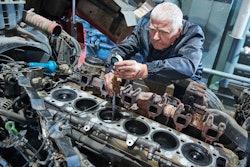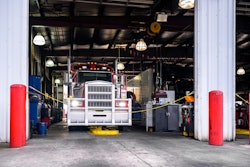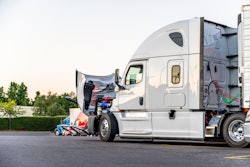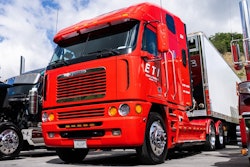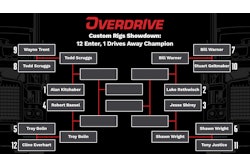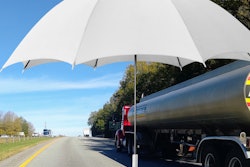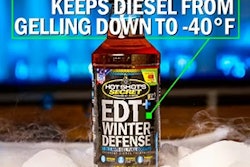Is a trailer worth the investment? For many owner-operators, the answer is a solid yes. It can take less than four years to earn back the investment, even when buying new equipment.
In the somewhat recent past, Overdrive research showed most independent owner-operators already owned at least one trailer, as did about half of leased owner-operators. Today that could be changing faster than in years past given the proliferation of trailer-pool progams with drop-and-hook opportunities not only leased to a carrier but in brokers' power-only programs. Yet still, leased operators without a pressing need for a trailer purchase could still find ownership comes with significant addition to earning potential.
Many carriers, whether using percentage or per-mile pay models, offer 5% to 10% more compensation to owner-operators who bring their own trailer. The owner-operator keeps more than half that.
If a dry van load pays the carrier $2/mile, for example, and an owner-operator was paid 70% of that, they'd gross $1.40 a mile. With a trailer acquisition and a percentage of 75%, for example, the per-mile rate bumps up to $1.50. On an 800-mile trip, that’s $80 extra.
Leased dry van owner-operators who are clients of ATBS averaged roughly 7,500 miles a month from June 2022 through June 2023. An extra dime per mile would have earned them an additional $750 in revenue per month, based on the example above.

For a three-year loan on a new trailer purchase, monthly payments and insurance might be $800 to $900, meaning owner-operators in that scenario initially would get close to breaking even more or less immediately. A used trailer purchase with a payment of only $400 to $500 a month? The owner would net nearly $400 a month from the word go.
Some independents own more than one trailer for versatility, haul van freight one day and flatbed freight the next. It's not out of the question for leased owner-operators, either. One big advantage of trailer ownership for owner-operators is the peace of mind in knowing who’s in charge of maintaining trailer tires, brakes and other components. On the other hand, that maintenance is a responsibility that bobtail-only owners don’t have.
Many fleets pay more to drivers with their own trailers, but it can be tricky to determine if that premium is worth the added costs of ownership. New dry vans cost $40,000 or more, and maintenance costs, primarily for tires and brakes, can average $1,500 a year or more.
To assess the value of bringing your own trailer into a lease arrangement, add the expected revenue with a trailer, and subtract the estimated associated costs. Then compare that number to the expected revenue without a trailer.
Even if that spread seems promising, consider how using your own trailer will affect your freight arrangements.
As long as a leased owner-operator can stay busy without incurring too many out-of-route miles, the investment in a trailer could be worth it. An owner-operator who owns a trailer also has more responsibility for staying loaded -- those increasingly common carrier drop-and-hook operations are mostly off-limits unless you leave the trailer at the yard.
[Related: To own or not to own a trailer: How COVID fast-tracked an explosion in power-only trucking]
Smart trailer spec’ing
Factors such as maintenance expenses, longevity and handling ease play vital roles in getting what you want in a trailer. You won’t realize low cost per mile if your trailer breaks down, is expensive to maintain or can’t handle your loads well.
Knowing definitively what you intend to transport, where you plan to work and how long you intend to keep the equipment will help you balance price with projected maintenance costs. Smart choices will keep your operating costs low and your resale value high.
KNOW YOUR APPLICATION. At spec’ing’s core is understanding your application. Hauling heavy-footprint products such as paper rolls requires higher floor ratings. Applications with additional equipment such as automotive racks require interior designs that protect the trailer from damage during loading and unloading.
Loading cycles can vary greatly -- from weekly to multiple daily loads. The greater the frequency, the faster the equipment wears.
Consider your trailer’s versatility, spec’ing the size, model, style and axle and suspension configuration so you can run the trailer in several states, as well as in Canada. If you intend to haul in California, be aware of laws that involve trailers. California is the only state that has an axle spacing law that requires the distance from the kingpin to the rear axle be 40 feet or less. In other states, 43 feet is typical. Spec’ing a sliding axle will give your trailer the versatility to meet standards in California and other states.
MINIMIZE MAINTENANCE. Spec premium quality for components such as long-life brake linings, wide brakes, long-life wheel ends and seals. Controlling corrosion also will reduce maintenance worries. You’re reducing cost per mile and maintenance costs by spec’ing special coatings that protect trailer parts. Some trailer manufacturers offer galvanizing to protect door frames, hinges and the entire subframe.
Spec’ing any system that eliminates wearable parts will minimize maintenance.
Hendrickson’s Intraax suspension integrates the axle into the beam with no wearable parts on the axle connections. In reefers, a glass-reinforced thermoplastic liner can reduce maintenance expense and help the trailer maintain excess cooling capacity, reducing operating costs.
Similar premium products could include a puncture guard liner to protect the trailer interior against punctures, thermoplastic coating to apply to suspensions and landing gear, and a steel liner with a rigid backing instead of a plywood liner.
[Related: What's 1 extra mpg worth in profits at today's freight rates? How about an extra 3 mpg?]
REDUCE WEIGHT. Weight reduction helps operators who typically “load out” at 80,000 pounds because it means additional payload capacity. It also helps those who usually “cube out” on space, because for every 300 pounds you eliminate, you gain 0.2% in fuel efficiency, experts say.
The biggest weight saver is spec’ing aluminum, which also is more corrosion-resistant than steel. You can spec aluminum side posts and roof bows in dry vans. Aluminum can be substituted for steel in crossmembers that support the floor and for hardwood flooring. Aluminum rims can replace steel wheels.
SPEC FOR FUEL SAVINGS. The same physics that apply to tractor fuel economy improvements can be applied to the trailer. The more aerodynamic the tractor, the more critical it is for the trailer to play a complementary role in streamlining airflow. Studies have shown that the fuel-economy difference between a typical fleet van and a more aerodynamic trailer is 1 mile per gallon or more.
An owner-operator could add $10,000 or more to his bottom line in one year by using a trailer with strong aerodynamic features. That means the trailer would pay for itself long before it wears out.
Read next: Routine preventive maintenance will pay owner-operator dividends long-term



